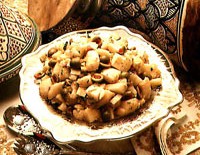The Art of Storytelling in Jemaa el-Fnaa: A Timeless Tradition

Jemaa el-Fnaa – Photo source: Wikimedia Commons
By Rania Basria / Arab America Contributing Writer
Jemaa el-Fnaa, Marrakech’s bustling core, is more than just a market. By day, it’s bustling with food vendors, snake charmers, and artists. But as the sun sets and the area is bathed in orange light, a shift occurs. The center plaza transforms into a lively stage for an ancient art: storytelling. For generations, Jemaa el-Fnaa has served as a gathering area for both Moroccans and visitors. The hikayat, or storytelling tradition, is key to its ongoing attractiveness. Arab America contributing writer, Rania Basria, says these stories, passed down through generations, show Morocco’s rich cultural legacy by combining parts of history, folklore, and moral precepts.
The Role of the Hkaya (Storyteller)
The hkaya, or storyteller, is more than just an entertainer. In Moroccan culture, they are regarded as the keepers of history and wisdom. Sitting in a circle of attentive listeners, the hkaya tells stories that are both entertaining and informative. Their expressive voice and gestures bring characters and events to life even when they only have a stick or a book in hand.
Storytelling at Jemaa el-Fnaa is a communal experience. Laughter, gasps, and cheers erupt from the audience, which ranges from young toddlers to seasoned elderly. This contact is important to the hkaya’s performance, as it brings the stories to life and makes them more relevant to the audience.
Themes and Tales of the Square
The stories told at Jemaa el-Fnaa are as diverse as the audience that gathers to hear them. Many stories from Morocco’s oral traditions feature heroic heroes, crafty tricksters, and magical characters. Some tell the story of Aicha Kandicha, a mythical spirit who serves as both a cautionary tale and a symbol of resistance. Others explore stories of love, betrayal, and the victory of good over evil.
Religious and historical stories have an important role. To inspire and educate, stories from Islamic history, saints’ lives, and city foundations are told. These stories frequently impart moral lessons, combining amusement with a feeling of purpose.
Storytelling as a Living Tradition
While storytelling is deeply ingrained in Moroccan society, it faces modern-day obstacles. The proliferation of digital entertainment and evolving social dynamics has resulted in a decrease in the number of hkaya. Storytelling, which was formerly the most popular type of public entertainment, now competes with music, acrobatics, and street theater.
However, attempts are being made to conserve this art form. Cultural organizations and festivals in Morocco have launched projects to document and revitalize oral traditions. Programs that encourage budding storytellers are helping to keep hikayat a dynamic part of Jemaa el-Fnaa’s culture.
The UNESCO Recognition
In 2001, UNESCO designated Jemaa el-Fnaa as a Masterpiece of Humanity’s Oral and Intangible Heritage. This distinction highlights the square’s importance as a center for cultural exchange and preservation. The award has not only drawn international attention to Jemaa el-Fnaa, but it has also highlighted the importance of storytelling in Morocco’s cultural environment.
The Modern Audience’s Role
Today, Jemaa el-Fnaa continues to attract a wide audience. For travelers, the stories provide insight into Moroccan traditions and values. For residents, they serve as a reminder of their common heritage. This diverse group of listeners guarantees that storytelling in the square stays dynamic, adapting to modern tastes while maintaining its essence. Visitors to Jemaa el-Fnaa frequently describe hikayat as transforming. The stories are more than just entertainment; they offer a bridge between the past and the present, demonstrating the continuing power of oral traditions.
How to Experience Storytelling in Jemaa el-Fnaa
To properly enjoy the art of storytelling at Jemaa el-Fnaa, one must join the crowd. The ideal time to visit is in the evening, when the square is filled with performers. Look for a circle of listeners with a storyteller in the center, gesturing animatedly. Even if you don’t understand Arabic or Amazigh, the performance’s emotions and passion will captivate you. For a more personal connection, consider hiring a local guide to translate the stories. Many guides understand the subtleties of Moroccan folklore and can contextualize the stories. This enhances the experience, particularly for those interested in understanding the cultural elements of the stories.
Storytelling in Jemaa el-Fnaa is more than an art; it is a cultural treasure that continues to inspire and connect people. Amidst the cacophony of modern life, the timeless tales of the hkaya offer a moment of pause, a chance to reflect on universal themes of humanity. As long as the stories are told and the audiences gather, Jemaa el-Fnaa will remain a living testament to the power of narrative, a place where the past and present meet in the timeless dance of words and imagination.
Check out our blog here!








